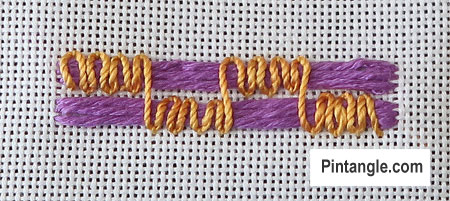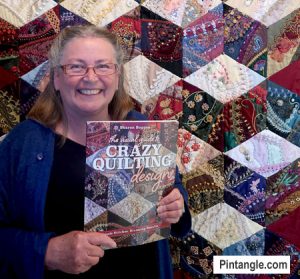Persian Border Couching is an interesting couching stitch, that could be used on the edges of items or simply worked row upon row to build up a fill pattern. Despite the name, I am not sure this stitch is actually from “Persia” or Iraq and Iran but that is how this stitch is named in Anne Butler’s Batsford Book of Embroidery Stitches.
For a contemporary twist, you could use novelty threads either on the top or even as part of the foundation threads. You could also incorporate beads along the way to add extra zest.
How to work Persian Border Couching
In Persian Border Couching you use 3 different threads: a foundation thread, a couched thread and a working thread that secures the couched thread. In the illustrations below I have used a purple foundation thread, the couched thread is yellow silk and to secure the couched thread to the fabric I used a yellow sewing cotton for my working thread.
 First lay a few lines of straight stitches that you will couch over.
First lay a few lines of straight stitches that you will couch over.
 Bring the thread you are going to couch up from the back of the fabric.
Bring the thread you are going to couch up from the back of the fabric.
 Take the thread that you are going to couch across the top of the foundation stitches. Bring your working thread up from the back of the fabric and with a little tacking stitch secure the couched thread to the fabric. As you make the tacking stitch pass the needle under the fabric. Have it emerge on the opposite edge of the foundation stitches. Wrap the couching thread under the needle. Make a tacking stitch to secure the couched thread.
Take the thread that you are going to couch across the top of the foundation stitches. Bring your working thread up from the back of the fabric and with a little tacking stitch secure the couched thread to the fabric. As you make the tacking stitch pass the needle under the fabric. Have it emerge on the opposite edge of the foundation stitches. Wrap the couching thread under the needle. Make a tacking stitch to secure the couched thread.
Note if the wrapping then tacking feels awkward, simply hold the couching thread with your thumb while tacking it into place. Wrapping the couching thread under the needle gave the couched thread a nice loop but it did feel it was awkward at times.
 Continue, by passing the needle with the working thread under the fabric again and wrap the couching thread under the needle to make your next tacking stitch.
Continue, by passing the needle with the working thread under the fabric again and wrap the couching thread under the needle to make your next tacking stitch.
 Continue down the line of foundation stitch zig zaging the couching thread across them. Once you have the couching process established try the double band.
Continue down the line of foundation stitch zig zaging the couching thread across them. Once you have the couching process established try the double band.
How to work Persian Border Couching with two lines of foundation stitches.
In Anne Butler’s Batsford Book of Embroidery Stitches Persian Border Couching was illustrated with a set of two foundation rows. This is how it is done.
 Make two sets of foundation stitches.
Make two sets of foundation stitches.
 Work 4 or 5 of the couched stitches then take your couched stitches across both sets of foundation stitches to the bottom line as illustrated.
Work 4 or 5 of the couched stitches then take your couched stitches across both sets of foundation stitches to the bottom line as illustrated.
 Work 4 or 5 couched stitches, then move to the upper line of foundation stitches. Continue along the rows in this manner to create the Persian Border Couching
Work 4 or 5 couched stitches, then move to the upper line of foundation stitches. Continue along the rows in this manner to create the Persian Border Couching
Below is a sample sheet of some of the threads you can couch using Persian Border Couching
 Persian Border Couching Variation
Persian Border Couching Variation
At one point I thought it would be easier to simply work a line of offset running stitches along both sides of the foundation stitches and lace your top thread.
Here is sample worked that way.

This variety of Persian Border Couching would work for a thread that was smooth, or with a good twist such a cotton perle #5 or #3. Many of the metallic threads can be laced easily too. But this lazy woman method would not work for any of the bumpy, hairy or novelty threads.
Please note in Anne Butler’s Batsford Book of Embroidery Stitches the stitch is photographed with 2 rows of 2 foundation threads. I have worked my samples over 4 lines of threads to illustrate the stitching process. In the second set, I worked a double band over 2 rows of 3 foundation stitches. This is done mainly so that the photograph would be easily understood by readers. I also think it does not matter how many threads you couch over, as couching has always been an adaptable technique.
Persian Border Couching is an interesting stitch that I will be exploring more. If any of my readers have another published reference for this stitch or know it by another name I would love to hear about it. Please leave a comment and let me know.
Have you seen my book?

My book The Visual Guide to Crazy Quilting Design: Simple Stitches, Stunning Results shares detailed practical methods on how to design and make a crazy quilt. Topics such as fabric choice, tricky challenges like balancing colour, texture and pattern, and how to create movement to direct your viewers eye around the block are covered in detail. I also explain how to stitch and build decorative seam treatments in interesting and creative ways. My book is profusely illustrated as my aim is to be practical and inspiring.
 Stitchers templates
Stitchers templates
My templates aim to help you take your stitching to the next level. Designed by an embroiderer for embroiderers. With them you can create hundreds of different hand embroidery patterns to embellish with flair. These templates are easy to use, made of clear plastic so you can position them easily and are compact in your sewing box.
These are simple to use. You simply position the template in place and use a quilter’s pencil to trace along the edge of the template. Stitch along this line to decorate the seam. I have a free ebook of patterns to accompany each set which illustrates how they can be used.
TO ORDER your Stitchers Templates
Crazy Quilt Templates set 1 you will find here
Crazy Quilt Templates set 2 you will find here



Thank you
I have set one.
I have not used it. I’m trying to get projects done.
I believe I downloaded a set of instructions to go with them. That computer crashed. Is there a way to get another download. Thankk you
Pamela I sent you an email with the link the download the file
Thank you, Sharon.
I’m going to try it out as this stich is new to me. Let you know how it’ll work out as a border for my free form embroidery projects(currently a belt and a tissue handkerchief case, the base being thin woolen felt).
It may be a good alternative to the border I use currently: a row of blanket stiches on which I embroider rows and rows of stem stiches until the blanket stiches are invisible and the border neat.
HI Janson – let us know how it behaves as I would be interested and I am sure many readers would too
I love it, so many possibilities! Thankyou So Much Sharon.
This looks like a great stitch. Got to try it!
That is a very interesting stitch.
Thank-you Sharon,
I love the variety this stitch affords.
Now I have your amazing and so delightful book, I am keen to try everything. I am promising myself time to begin on a project during the summer whilst sitting in the cool of an airconditioner.
Thanks Marilyn – Just dive in no need to wait – and have fun
Thank you!